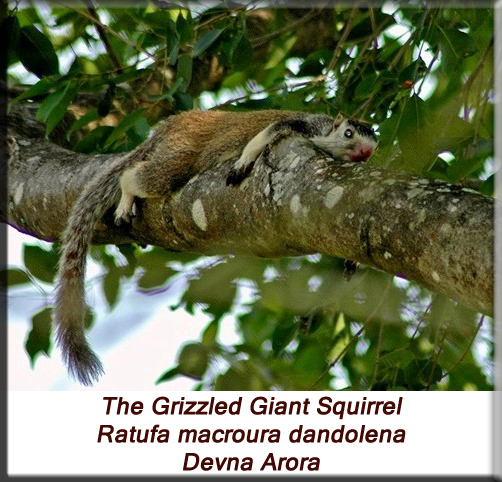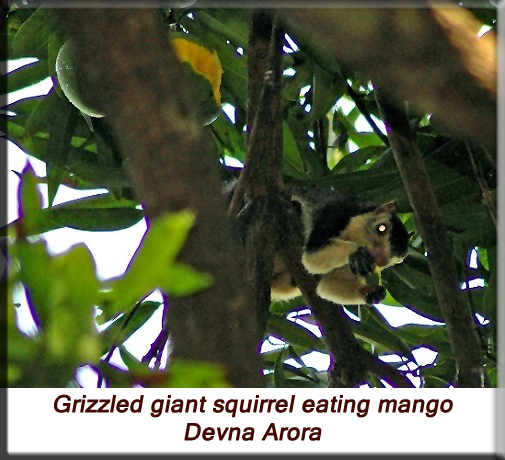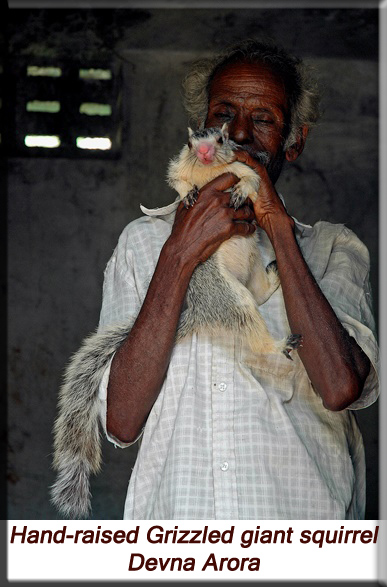Notes on hand-rearing the Grizzled Giant Squirrel, R. m. dandolena
Devna Arora
The Grizzled Giant Squirrel
The Grizzled Giant Squirrel Ratufa macroura, endemic to the Western Ghats of Tamil Nadu and Kerala (India) and Sri Lanka, is a large cat-sized squirrel but is the smallest of the giant squirrels. There are three sub-species of the Grizzled giant squirrels of which only R. m. dandolena is found in 4 isolated pockets in Southern India.
The Grizzled giant squirrels are highly arboreal mammals equipped with large, broad forepaws that are well adapted for gripping and climbing trees. They live in the tree canopy and seldom descend to the ground. The body measures 1-1½ feet with a tail of a similar length if not longer, and they weigh between 1-2 kilograms. The size and coloration varies greatly by locality and it is not uncommon to find various shades of red, brown, grey and black but the ventral side is always lighter.
Endemic to montane and riverine habitats of the Western Ghats, significant numbers of the squirrels can now be found in the adjoining orchards [where coconut, mango, tamarind, jack fruit, guava, sapota, lemon, goose berry, etc. are grown] due to widespread destruction – lack of canopy cover and suitable nesting trees in their natural habitats.
Little is known about the breeding cycle of R. m. dandolena but the species breeds in late summer giving birth of 1-2 young. The nests are large, cup-shaped or globular structures made up of small branches, twigs and leaves. Adult squirrels may make several nests, not all of which are used for breeding. Nests are built high in the canopy on tall trees that are at least 5-7 meters in height and a favoured choice of nesting trees is often mango, tamarind or Albizia sp.
The diet of the Grizzled giant squirrels is similar to that of other arboreal squirrels with fruits, seeds and nuts making up the bulk of the diet and invertebrates and other small animal protein consumed opportunistically. The also nibble on buds, stalks, twigs, etc. Harder surfaces like barks of trees will be preferred by older squirrels that need to constantly keep trimming their teeth.
Hand-raising by the Paliyan tribes
The Paliyan, also known as Palaiyar or Pazhaiyarare, are an indigenous forest tribe dwelling in the South Western Ghats esp. Tamil Nadu and Kerala. With assistance and guidance from the Wildlife Association of Rajapalyam (WAR), several squirrels have been benevolently hand-raised and released back in their natural habitats by the Paliyans.
Young squirrels are typically found at ages of 2-4 weeks after they have fallen from their nests. Such babies are taken home (they live in small houses in the forest fringes) and housed in small hammocks (as are their own babies) or cloth bags. Babies are given diluted milk formula and fed with a ‘paladai’ – a traditional oil lamp. Sterilization has never been an issue as the paladai can be washed with other house-hold utensils.
Once older, the young squirrels are given fruits gathered from the forests. A process of soft release is followed from home allowing the squirrel to play outside the house and return at its will until completely independent.
Hand-rearing the Grizzled Giant Squirrel – Guidelines for rehabilitators
Hygiene
The first and foremost point to remember when handling babies is hygiene. Babies are extremely delicate and have sensitive immune systems. While new-borns require meticulous hygiene practices, older babies require less stringent measures – they require cleanliness rather than sterilization.
Housing
Babies under a month old must be housed indoors and kept in small baskets, or wooden or cardboard boxes. They must be kept on a bedding of soft cotton cloth which must be changed each time it is soiled. New-born babies require some external heat until they are a month old – this must be done keeping the weather temperatures in mind as summer temperatures can go well beyond tolerance; additional heat can be crucial for young babies during the monsoons. As a rule of thumb, kittens require external heat round-the-clock until they are 2-3 weeks old with external heat being gradually withdrawn during the day in the 3rd week and thereafter provided only at night until the kits are 4-6 weeks old.
Kittens over a month old may be shifted to sheltered enclosures but they MUST have access to a warm nest box that they can sleep in. Wicker baskets or picnic baskets can used to simulate the conditions of the natural nests. Ensure that the baskets are lined with adequate amounts of warm cloth and kept in a sheltered part of the enclosure. Bedding must be checked at sundown each day to ensure the kits have warm and dry bedding for the night.
Once the kittens are over 2-3 months old, the nest boxes must be moved high up in the enclosure as the kits will instinctively want to sleep in higher spaces. It would also be beneficial to house the kits in high enclosures with adequate tree canopy.
Feeding
The diet of Grizzled giant squirrels is similar to that of other arboreal squirrels and similar feeding practices can be followed for them. Kittens up to a month old must be stimulated after every feed – this is important for proper functioning of the bowels and timely elimination of body wastes. The squirrels can be weaned at the age of 8-10 weeks after which they will primarily be on a diet of seeds, nuts, fruits and other protein supplements.
Although KMR (Kitten Milk Replacers) is the most suitable milk substitute for squirrels, Lactogen, Farex Milk of Nan Pro may be used for hand-rearing infant squirrels. Formula must ONLY be made with boiled water. Formula may be made for the entire day and refrigerated. Only a part of the formula that is required for the feed must be warmed per feed and the remainder must be discarded. Refrain from using fresh cow’s milk as wild animal babies don’t often digest it.
Probiotics and digestive enzymes must be added to any milk formula that is being used for the kittens. Vitamins and calcium supplements must be introduced once the kits have settled down and are feeding well.
Formula for neonates:
Week 1: 7 parts water + 1 part formula milk powder + Probiotics
Week 2 until the eyes open: 7 parts water + 1 part formula milk powder + 0.25 parts boiled egg yolk + 0.5 parts of **infant cereal + Probiotics + Vitamins + Calcium
Formula to be used once the eyes open:
6 parts water + 1 part formula milk powder + Either 1-2 parts of **Farex or Cerelac (fruit flavours) OR 1 part of Nestum + 0.5 parts egg yellow (boiled egg only) + Probiotics + Vitamins + Calcium
** Do note that Farex and Cerelac both contain roughly 35% of milk.
Stage-wise feeding guidelines
New-born kittens until the eyes open
New-born kittens are extremely delicate with very sensitive digestive systems. They require utmost care both in terms of feeding and hygiene until they are little older. New-borns may be fed with syringe feeders until they are 2-3 weeks old and the feeders MUST be sterilized after every feed. A milk bottle may be used if both you and the kitten are comfortable with it.
New-born kittens must be fed at least 8-9 times a day with each feed being 2–2½ hours apart and a 4-6 hour gap given between their feeds at night.
Kittens under a week’s age may only be given formula with added probiotics and diluted with 30% boiled water. Kits over a week old may be given a similar formula but boiled egg yolk and vitamins must be added to the formula. Half an egg yolk, equally divided in all the meals, may be introduced in the third week and an entire egg yolk, similarly divided, may be given to the kittens in the 4th week. Infant cereals (the fruity ones preferably) like Farex, Cerelac or Nestum may be introduced in small quantities in the 3rd week.
2 weeks to a month old
Kittens of this age can either be fed with a syringe feeder or fed with a small milk bottle – those suitable for puppies and kittens and are commonly available at any pet store. The feeders and bottles MUST be sterilized after every feed.
Kittens between 2-4 weeks of age must be fed at least 6 times a day with each feed being 2–3 hours apart and a 6-7 hour gap given between their feeds at night. The formula highlighted above is most appropriate for kits of this age.
1 to 2 months of age
Kits of this age will begin to lap milk and can be shifted to shallow plates as these are easier to wash and clean. Feeding may nonetheless be continued with milk bottles if feasible.
Month-old kits must be fed at least 5-6 times a day with a 3 hour gap between the feeds during the day and an 8 hour gap between their feeds at night. Feeding must be gradually decreased to 2-3 (morning – afternoon – evening) feeds a day by the end of month. In addition to the formula, fresh fruits must be introduced to the kit’s diet. The kits should consume at least 2-3 meals of fruits by the end of the second month.
2 months until weaning
The kits must be actively weaned at this stage and the morning feed must be completely stopped at the beginning of the 3rd month. The kits must be completely weaned by the time they are 2½–3 months old. Seeds and nuts must be introduced to the kits diet and a whole boiled egg given a couple of times a week. Contact with caretakers must now be minimal.
Weaned young, i.e., squirrels over 2-3 months of age
The young squirrels will now consume an adult diet comprising of various seeds, nuts and fruits. Boiled eggs may be offered if the kits like them. Feeding enrichment must begin at this age and food must be scattered around rather than leaving it in one place.
Rehabilitation and Release
The ideal way to release hand-raised young is by means of a soft release. The young must be shifted to appropriate enclosures at the release site by the time they are 2-3 months old. The enclosure must have the facility of a window towards the top of the enclosure that can be opened to let the kits out – this opening must allow access to tress without requiring the kits to descend. Nest boxes must be placed high in the enclosure.
The soft release must begin by the time the young are 3-4 months old and the window to the top of the enclosure must simply be opened for them. The kits will move in and out of the enclosure for a couple of months until they are completely independent and supplemental feeding must be continued in the meanwhile.
If opting for a hard release, the young squirrels must be released only after they are 5-6 months old.

Acknowledgements
I thank Wildlife Trust of India (WTI) for giving me the opportunity to work on the Grizzled Giant Squirrel Project and the chance to visit Srivilliputtur Grizzled Giant Squirrel Wildlife Sanctuary in 2011 and Mr. R. Arumugam for facilitating the project.
I also thank Mr. T. S. Subramaniarajah and Mr. Shiam Rajah of Wildlife Association of Rajapalayam (WAR) for facilitating the project and their excellent conservation work in Tamil Nadu. I also extend my heartfelt thanks to them for giving me the chance to meet and interact with the local tribesmen and gain an insight into their interactions with the Grizzled Giant Squirrels.
References
Arora, D. (2013) Hand-rearing and rehabilitation of orphaned palm squirrles, Funumbulus sp. (revised) [Online], Rehabber’s Den. Available from: http://www.rehabbersden.org/Hand-rearing%20and%20rehabilitation%20of%20orphaned%20palm%20
squirrels.pdf [Accessed: 09/01/2013]
Blanford, W.T. (1888-91). Mammalia. In Blanford W.T. The Fauna of British India, Including Ceylon and Burma. London: Taylor and Francis, pp. 374-375.
Herlekar, I.R. (2010). Effect of canopy fragmentation on the patterns of habitat use of the grizzled giant squirrel Ratufa macroura in Cauvery Wildlife Sanctuary, Karnataka. Bangalore: National Centre for Biological Sciences, Tata Institute for Fundamental research. [Online] Available from:
http://msc.wcsindia.org/PDF/05_Ipsita%20R%20Herlekar%20Final%
20dissertation%202010.pdf [Accessed 09/03/11]
IUCN Red List (2011). Ratufa macroura. IUCN Red List of Threatened Species. [Online] Available from:
http://www.iucnredlist.org/apps/redlist/details/19381/0[Accessed 09/03/11].
Prater, S.H. (1971). The Book of Indian Animals. 3rd Ed. Bombay: Bombay Natural History Society.
Protocol published in 2013



